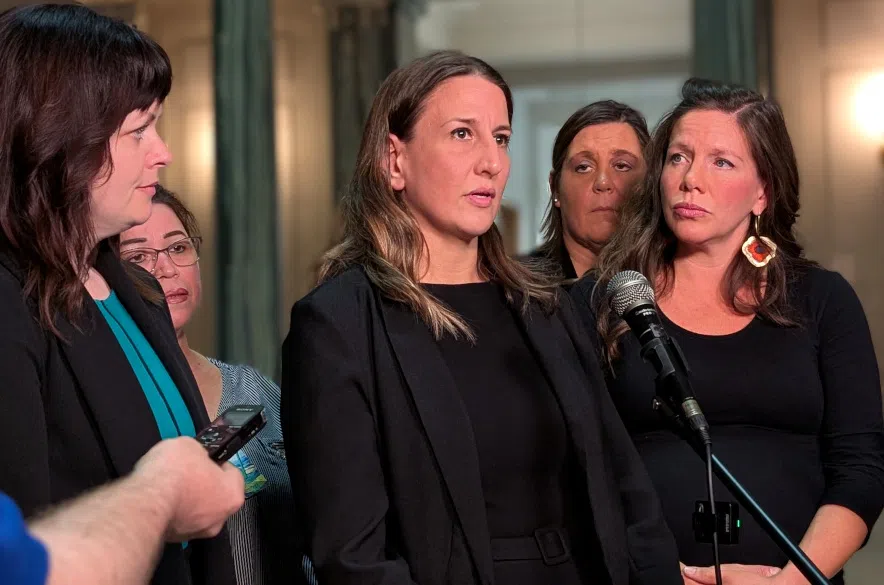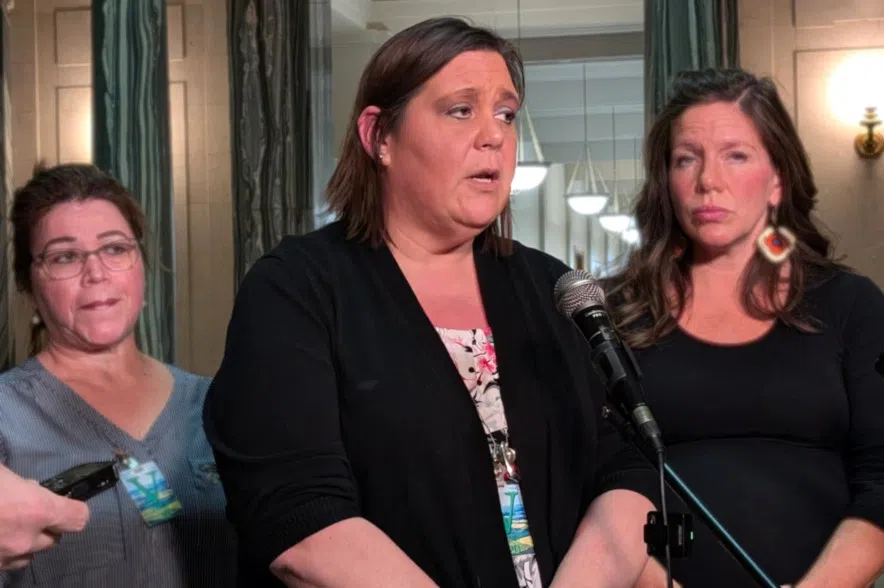Gerri Grant’s voice filled with emotion as she talked about quitting her job as an interventional radiology technologist at the Regina General Hospital, knowing it would put more pressure on the employees left.
“I knew that by my leaving, it only increased the problem,” she said.
Grant was speaking in the rotunda at the legislative building Thursday morning, standing with the Sask. NDP to talk about the serious problems brought to light in the interventional radiology department at her former hospital.
Read more:
- ‘People are struggling’: CUPE health-care workers call for better wages
- ‘It’s terrifying’: Health-care workers sound alarm at Legislative Building
- ‘Dangerous’: Medical techs warn Sask. govt of issues caused by staffing shortages
The NDP had a letter, signed by 15 workers in the department, talking about the problems caused by short staffing and what it was doing to the workers still there and the quality of patient care.
The letter talked about “overwhelming challenges” with little to no action having been taken, which left staff “overworked, unheard and deeply frustrated.”
It said the department has six of ten technologist positions and five of nine nurse positions empty.
The letter said there are frequently days when there is no interventional radiologist available, which forces patient cases to be delayed or rescheduled, and that a lack of doctors has resulted in cases where patients didn’t get life-saving treatments in time.
There is so much work left for the staff who are in the unit; they have to work overtime and are mandated to cover additional on-call shifts, and vacation requests are regularly denied.
The letter said workers often have to do things that aren’t their job—nephrologists are performing tunnelled lines, anesthesiologists are performing spine and pain therapy, and there’s been a drastic increase in complex endovascular procedures like vascular treatments and trauma embolization.
And because there isn’t enough staff in the unit, an interventional radiology suite can’t be used to its full capability.
This letter also talks about poor communication and operational efficiencies – that workers are expected to complete a full case schedule even though two of their procedure rooms have been given over to a new full-time PICC program, and a pain clinic once a week.
It said the nurse educator isn’t available for onboarding because of competing demands, the manager is largely absent and concerns are rarely addressed, and the supervisor is rarely included in decisions.
These problems are what led to Grant leaving her job last summer.
“I gave up a really fabulous, engaging career just watching my co-workers struggle (and) myself struggle with that work-life balance. We were taking on call hours at an excessive rate – you would be working your regular shifts as well as on call – watching patients suffer,” she explained, saying she finally couldn’t handle it anymore.
Since Grant left, she said four more technologists have left the unit as well, “we’re all just feeling the pressure.”
Dionne Wagner is the CUPE area representative, she said this has been a problem for years.
“The emails coming in non-stop from the radiology department because of mandating, because of short-staffing, because of the (unsafeness) of it, because of the long waits on our patient care,” she said.
In its efforts to recruit workers, the provincial government often talks about the seats it’s funded for health-care worker education, but Wagner said the health-care system in Saskatchewan can’t retain the graduates.
“They’re bringing them in but these people are leaving our province and going elsewhere to other places for radiology departments, and we just can’t seem to keep them in Saskatchewan for us to maintain our staffing levels,” Wagner said.
She explained it has to do with pay, safety and recruitment and retention issues.
“Our morale, in the whole hospital, I would say, has been down for quite a few years now just because of so much short-staffing, so many people burnt out,” she explained.
Health Minister Jeremy Cockrill said he had only recently seen the letter before speaking to media about it.
The letter was only sent to the technologists’ union in recent weeks, but the NDP said it brought up the situation in the radiology unit in October last year, and Wagner said she brought it up with the minister at a recent CUPE meeting as well.
He said the Saskatchewan Health Authority had signed contracts with two private Regina-based radiology groups in recent months to provide those services in the hospitals.
“As we get those agreements up and running and in place, that should help to stabilize radiology services,” said Cockrill.
He said the problems in the unit were why the agreements were launched.
“I understand there’s challenges, and people who feel those challenges are people who work on the floor every day and also the patients, so we take that very seriously,” said Cockrill.
The minister couldn’t say when those agreements would begin.
Cockrill said such groups have been used in the past to provide those services.












